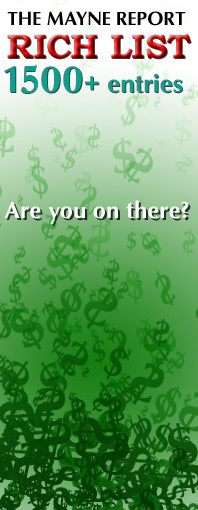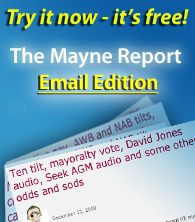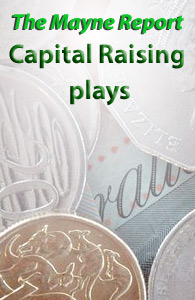ASX shows how not to do corporate democracy
September 3, 2008
Dear Mayne Reporters,
the clock is ticking on the September 24 ASX board tilt with the all-powerful proxy advisers set to send out their recommendations next week. We've put together the following package for ASX shareholders which wraps up the platform, history, audio files from relevent AGMs, media reports and ratings on the various ASX directors. There's plenty of meat, so check it out.
The monopoly exchange is under the microscope right now after today's front page story in The AFR suggesting the Federal Government will give the go ahead for new competitors to enter the market. And so they should when you consider ASX has long been Australia's most lucrative government-endorsed monopoly, which is more interested in profit than market integrity.
The 606 original stockbroking owners of the ASX, back when it was a mutual serving the investing public in a not-for-profit way, have seen their $25,000 investment in membership turn into more than $7.3 million. These brokers paid just 15c for each of their 166,000 shares and the fully franked dividends have flowed as follows since the 1998 demutualisation:
1998-99: 34.9c
1999-00: 66.2c
2000-01: 55.3c
2001-02: 49.6c
2002-03: 67.1c
2003-04: 80.7c
2004-05: 95.1c
2005-06: 120.1c
2006-07: 163.8c
2007-08: 192.4c
Total: $9.25.
Throw in today's share price of $34.99 and you are talking a total value of $7.33 million which equates to a 293-fold return on that original $25,000 investment.
How ASX runs its elections
One major bone of contention in the current election is ASX's refusal to provide a free copy of its top 200 beneficial shareholders. ASX chairman Maurice Newman, who also leads the governance at the ABC as chairman, was the first company chairman to consent to such a request when I ran for the ASX board in 2001 and it has become routine in more recent tilts, with the likes of AMP, Fairfax and even Gunns complying.
Alas, a written request for the ASX top 200 sparked this reply:
ASX does not intend to supply you with free and direct access to the top 200 beneficial holders of ASX shares. ASX does not see how the supply, as ASX's cost, of this ASX information to you in this context can be in the best interests of ASX. You will no doubt appreciate your statutory entitlement to inspect ASX's register of relevent interests to obtain available information on beneficial interests in ASX shares.
Er, it's actually called corporate democracy. ASX is a public company and its register is a public document. I'm sending this update to federal politicians of all colours to highlight the outrageous rorting that goes on in corporate elections.
It was Peter Costello who created the ASX monster as a for-profit monopoly regulator in 1998, so let's compare what happened when I ran against him in Higgins last year with what ASX is serving up.
Federal election process
The Higgins process was run by the independent Australian Electoral Commission which declared the number of vacancies before nominations closed and immediately made available a hard copy and electronic version of the electoral roll once nomination qualifications were satisfied. The independent AEC then conducted a secret ballot in which I was able to appoint scrutineers to oversee vote counting. All candidates were given the same information at the same time and whilst voting was compulsory, constituents had to correctly fill in the ballot paper to vote.
ASX election process
This is what the monopoly operator of our stockmarket is serving up. After seeing that there were three nominations, the board unilaterally declared there was only two vacancies, even though the ASX constitution provides for shareholders to appoint several more directors. Telstra, with the Federal Government as its major shareholder, has always set the standard by giving shareholders the opportunity to appoint as many directors as they like, up to the maximum prescribed in the constitution. ASX has also refused to provide useful summaries of its share register that it routinely accesses and won't be conducting a secret ballot with independent scrutiny because the board will receive regular summaries of individual votes during the proxy process. Voting is voluntary, but shareholders who just sign the form and send it back will give their votes as open proxies to the chairman who will vote them in favour of the incumbents and against the challenger. Because of this rort, even 100% of the directed proxies in favour won't be enough to win. The whole process will be overseen and administered by Link Market Services, a share registry business that used to be 50% owned by ASX. I'm unable to appoint scrutineers and there is no electronic audit trail in Australian corporate elections.
Tackling the infrastructure rorts
Finally, it is important to focus on what this campaign is all about - ending the rort of Macquarie and Babcock's Bermuda-registered and ASX-listed infrastructure vehicles that are littered with poor governance and disclosure.
The reputation of Australian markets suffered when the likes of Risk Metrics globally release reports like this one, which damns the listed infrastructure fiasco. The Wall Street Journal recently produced this critical piece and even The Economist has just had a go. We don't need this sort of bad publicity, let along the billions of dollars in losses, and it could have been prevented if ASX had just upheld some better standards, rather than seeking to maximise its listings revenue which hit $130 million in 2007-08.
That's all for now, but don't forget to check out the ASX website package.
We'll have another update tomorrow after the AWB EGM finishes when we hopefully bury another governance fiasco that was waved through by those regulatory poodles at the ASX, creating the notorious farmer gerrymander.
Do ya best, Stephen Mayne
the clock is ticking on the September 24 ASX board tilt with the all-powerful proxy advisers set to send out their recommendations next week. We've put together the following package for ASX shareholders which wraps up the platform, history, audio files from relevent AGMs, media reports and ratings on the various ASX directors. There's plenty of meat, so check it out.
The monopoly exchange is under the microscope right now after today's front page story in The AFR suggesting the Federal Government will give the go ahead for new competitors to enter the market. And so they should when you consider ASX has long been Australia's most lucrative government-endorsed monopoly, which is more interested in profit than market integrity.
The 606 original stockbroking owners of the ASX, back when it was a mutual serving the investing public in a not-for-profit way, have seen their $25,000 investment in membership turn into more than $7.3 million. These brokers paid just 15c for each of their 166,000 shares and the fully franked dividends have flowed as follows since the 1998 demutualisation:
1998-99: 34.9c
1999-00: 66.2c
2000-01: 55.3c
2001-02: 49.6c
2002-03: 67.1c
2003-04: 80.7c
2004-05: 95.1c
2005-06: 120.1c
2006-07: 163.8c
2007-08: 192.4c
Total: $9.25.
Throw in today's share price of $34.99 and you are talking a total value of $7.33 million which equates to a 293-fold return on that original $25,000 investment.
How ASX runs its elections
One major bone of contention in the current election is ASX's refusal to provide a free copy of its top 200 beneficial shareholders. ASX chairman Maurice Newman, who also leads the governance at the ABC as chairman, was the first company chairman to consent to such a request when I ran for the ASX board in 2001 and it has become routine in more recent tilts, with the likes of AMP, Fairfax and even Gunns complying.
Alas, a written request for the ASX top 200 sparked this reply:
ASX does not intend to supply you with free and direct access to the top 200 beneficial holders of ASX shares. ASX does not see how the supply, as ASX's cost, of this ASX information to you in this context can be in the best interests of ASX. You will no doubt appreciate your statutory entitlement to inspect ASX's register of relevent interests to obtain available information on beneficial interests in ASX shares.
Er, it's actually called corporate democracy. ASX is a public company and its register is a public document. I'm sending this update to federal politicians of all colours to highlight the outrageous rorting that goes on in corporate elections.
It was Peter Costello who created the ASX monster as a for-profit monopoly regulator in 1998, so let's compare what happened when I ran against him in Higgins last year with what ASX is serving up.
Federal election process
The Higgins process was run by the independent Australian Electoral Commission which declared the number of vacancies before nominations closed and immediately made available a hard copy and electronic version of the electoral roll once nomination qualifications were satisfied. The independent AEC then conducted a secret ballot in which I was able to appoint scrutineers to oversee vote counting. All candidates were given the same information at the same time and whilst voting was compulsory, constituents had to correctly fill in the ballot paper to vote.
ASX election process
This is what the monopoly operator of our stockmarket is serving up. After seeing that there were three nominations, the board unilaterally declared there was only two vacancies, even though the ASX constitution provides for shareholders to appoint several more directors. Telstra, with the Federal Government as its major shareholder, has always set the standard by giving shareholders the opportunity to appoint as many directors as they like, up to the maximum prescribed in the constitution. ASX has also refused to provide useful summaries of its share register that it routinely accesses and won't be conducting a secret ballot with independent scrutiny because the board will receive regular summaries of individual votes during the proxy process. Voting is voluntary, but shareholders who just sign the form and send it back will give their votes as open proxies to the chairman who will vote them in favour of the incumbents and against the challenger. Because of this rort, even 100% of the directed proxies in favour won't be enough to win. The whole process will be overseen and administered by Link Market Services, a share registry business that used to be 50% owned by ASX. I'm unable to appoint scrutineers and there is no electronic audit trail in Australian corporate elections.
Tackling the infrastructure rorts
Finally, it is important to focus on what this campaign is all about - ending the rort of Macquarie and Babcock's Bermuda-registered and ASX-listed infrastructure vehicles that are littered with poor governance and disclosure.
The reputation of Australian markets suffered when the likes of Risk Metrics globally release reports like this one, which damns the listed infrastructure fiasco. The Wall Street Journal recently produced this critical piece and even The Economist has just had a go. We don't need this sort of bad publicity, let along the billions of dollars in losses, and it could have been prevented if ASX had just upheld some better standards, rather than seeking to maximise its listings revenue which hit $130 million in 2007-08.
That's all for now, but don't forget to check out the ASX website package.
We'll have another update tomorrow after the AWB EGM finishes when we hopefully bury another governance fiasco that was waved through by those regulatory poodles at the ASX, creating the notorious farmer gerrymander.
Do ya best, Stephen Mayne





















